The (Smokies) Great Smoky Mountains Park is home to dozens of wildlife. Some are pretty friendly; others prefer to stay out of sight, while others are dangerous and can pose a threat if not treated with proper respect. So, when you visit this amazing Park, keep a keen eye on its inhabitants – from a safe distance.
The Great Smoky Mountains are rich in biodiversity and scenic beauty. The landscape stretches over 500,000 acres between the States of Tennessee and North Carolina.
The Great Smokies National Park forms the largest wilderness making the area one of the crown jewels of the ecosystem, east of the Mississippi River. The Park includes wildlife, waterfalls, highland pastures, fresh mountain streams, high mountains, and extensive forests.
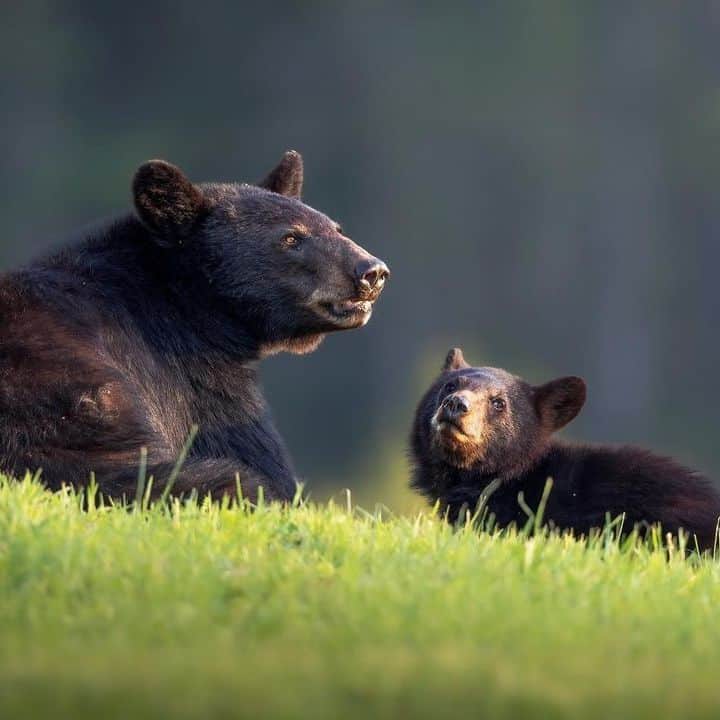
Because of its magnificence and proximity to the surrounding cities, the Park ranks as a top tourist destination in East Tennessee, making it a critical economic resource.
In this article, we have lined up some of the most common animals in the Smoky Mountains in no particular order.
So here we go.
Mammals in the Smoky Mountains
1. Black Bears

Nearly 1,500 black bears live in the Smoky Mountains national park. Giant bears weigh up to 600pounds and are not easy to find, while the Females weigh around 100 pounds, and the males weigh at approx. 250 pounds.
The Bears are mainly vegetarian; they like to eat plants – squawroot, insects, wild berries, and nuts are their favorite. They seem harmless at first glance, but are some of the most dangerous animals living in the smoky mountains when provoked.
If you spot one while hiking in the Park, stay away or back away slowly and calmly to avoid a wild chase. If the bear comes toward you, do not run, instead, scream continuously, and throw rocks to scare it away.
The black mountain bears hibernate during winter, so it’s hard to find any around this time. The best time to encounter Bears is in the spring and summer. You can watch them in Cades Cove or Cataloochee in the Smoky Mountains in the meadows near forests.
Bears come out of hibernation and can eat anything during this time. Humans are discouraged from feeding them because it reduces their lifespan significantly. Feeding bears is illegal in the Smoky Mountains.
2. Elk

The Great Smoky Mountains largest animal, the elk, weighs up to 700 pounds with a height of 5 Ft. at shoulder length. The elk population saw a sharp decline between the ’80s and ’90s but was reintroduced to the Park in 2001. You can easily spot them at Cataloochee roaming on the grasses as they graze in the open meadows.
The best time to see elks is at dawn or dusk, after a long night of rest and bright and early when they roam about looking for fresh wet pastures in the fords. Head out to the Park in the early summer to witness mothers give birth to adorable calves and September-October for the annual mating season when bulls circle cows into herds. While mostly docile and calm animals, elks may charge at potential threats, including humans, so it’s best to observe them from a distance.
3. White-tailed Deer
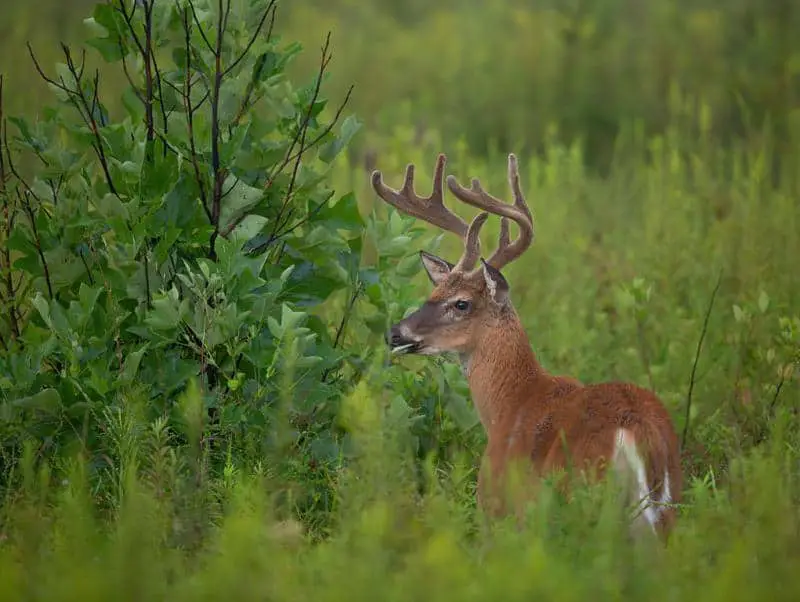
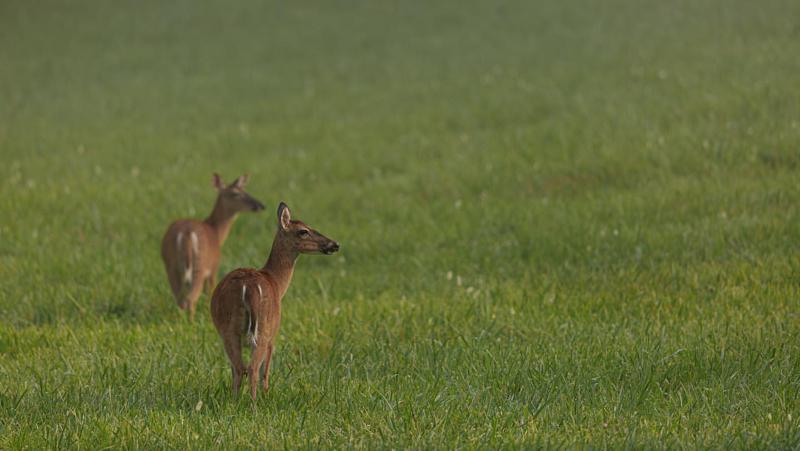
White-tailed deer are common in the Smoky Mountains Park. They dwell in the woods and meadows, where they browse on grass and other forest foliage.
Commonly known as Bucks in the region, they grow uneven horns every spring; used to fight other deers for mating rights by fall. At the onset of winter, deers drop their horns and develop fresh ones.
Fawns are born in spring and are adorned with spots to help camouflage them from predators in their early months of life. You can find white-tailed deers in Cades Cove and Cataloochee or when hiking on the forest trails.
Big Cats in the Smoky Mountains
4. Bobcats
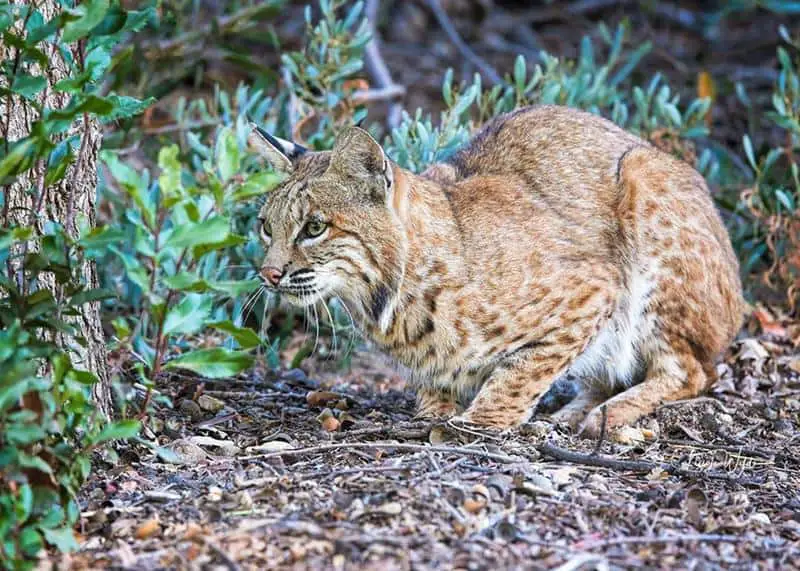
Bobcats are solitary, reclusive felines that live in theSmokies. They grow to a max weight of 70 pounds and 3 Ft. long. Bobcats have spotted coats, short ears, and stubby tails. These cats hunt small deers, rabbits, rodents, and birds as prey.
Bobcats are solitary animals and prefer to establish their territories and use scents to mark them against prowlers. Females give birth in late winter and can sire up to six kittens, which they raise for 6-8 months at most.
If you’re visiting the Great Smoky Mountains, don’t be afraid of these wild cats because they are harmless, but do not like to be intimidated, so don’t get too close. They are timid, nocturnal cats; you most likely won’t see them at all during the day.
5. Eastern Cougars
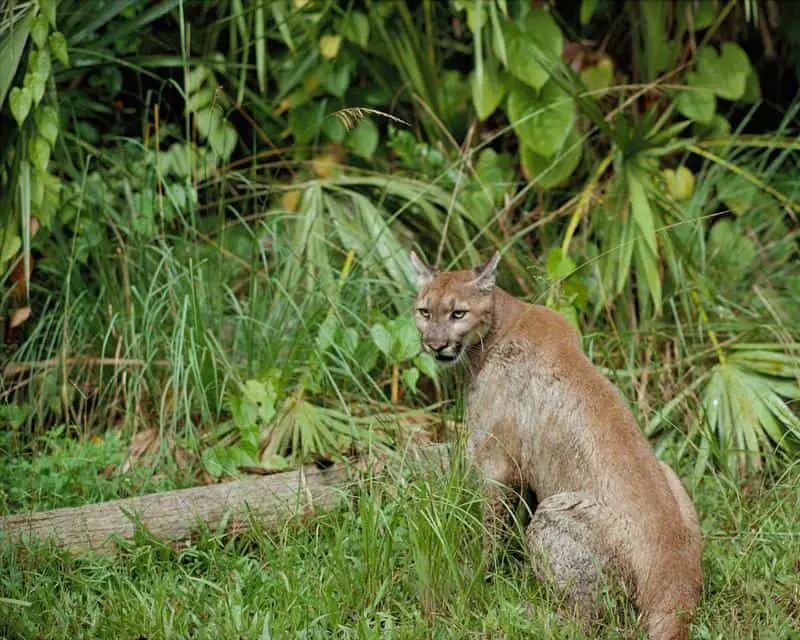
This is the only Mountain lion in the Smoky Mountains. Eastern Cougars are large, brown or gray cats weighing approximately 140 pounds, and stand between 5-8 Ft. tall as adults. The mountain Cougars seem shy and withdrawn, so they tend to stay out of sight, but they are dangerous.
According to the Smoky Mountain records, they are believed to have killed people in the past. So be careful not to wander too far off your tour group/guide while hiking in the Smoky Mountains.
Wild Hounds in the Smoky Mountains
6. Red and Gray Foxes
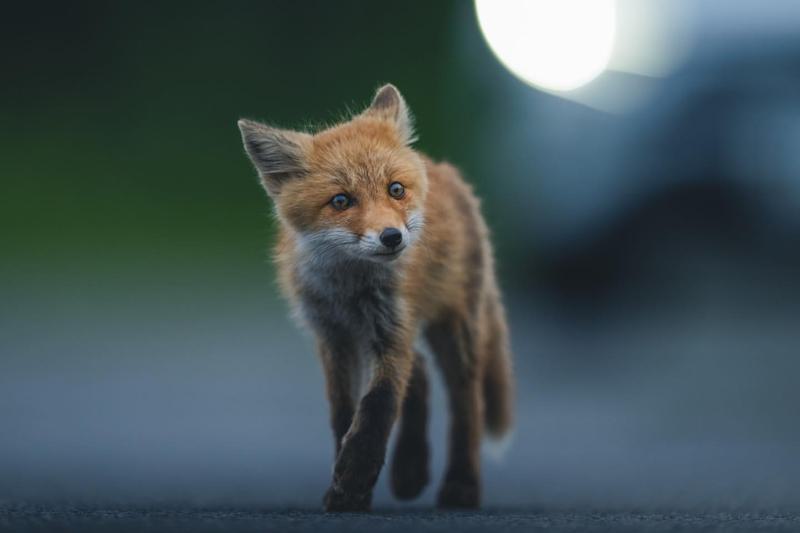
The Red Fox and the Gray Fox live in the Great Smoky Mountains National Park. Both species are elusive and nocturnal. They both grow from 20-25 lbs. as adults.
The Red Fox resembles a domestic dog in size, except for the white-tipped tail and black limbs, weighing up to 24 pounds. It’s easy to spot one in the Smokies due to their colorful red hue and fluffy tail. The Red Fox is a solitary animal typically hunting alone. It feeds on small game but can also eat human food if offered.
The Gray Fox differs from the red ones with their black-tipped tail, unlike the red foxes with a white tail. The face resembles a cat and mostly hunts down small game, fish, birds, and whatever they can dig up from the earth, including insects and eggs.
The red and gray fox are found near Cades Cove in Smokies Park.
7. Coyotes
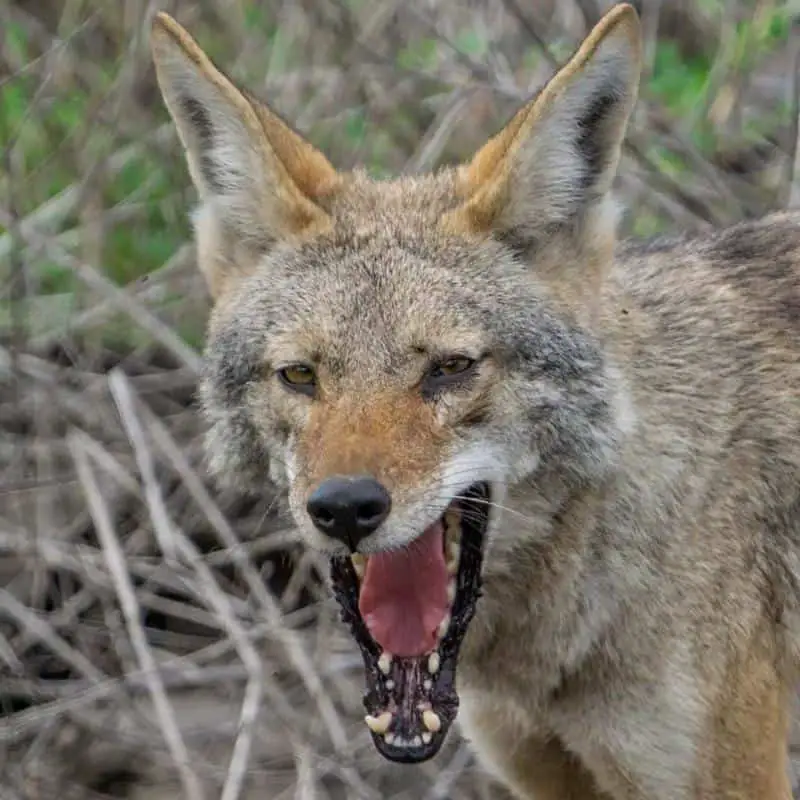
Coyotes resemble Collie dogs; they have dark fur, white bellies, and a fleshy, bushy tail. They like to howl at night. Coyotes grow to about 4 feet in length and weigh up to 50 pounds. They are immensely athletic, run at incredible speeds, and can quickly leap over an 8-foot fence.
Coyotes can be found in Cades Cove, and they hunt small prey while alone and can chase down larger animals while in packs. Coyotes are somewhat timid and afraid of humans at first glance, but can be dangerous if you cozy up to them. They are not friendly around pets and will not hesitate to kill on sight!
Coyotes adapt quickly to new environments and prefer to hunt at night. They mostly hunt fish, frogs, rabbits, and rodents. You can spot them anywhere in the Smokies.
Snakes in the Smoky Mountains
Most of the snakes you will encounter on your trip to the Peaceful Side of the Smokies are peaceful and reclusive reptiles. There are 23 varieties of snakes in the Smokies, but only two of them are poisonous.
8. Northern Copperhead
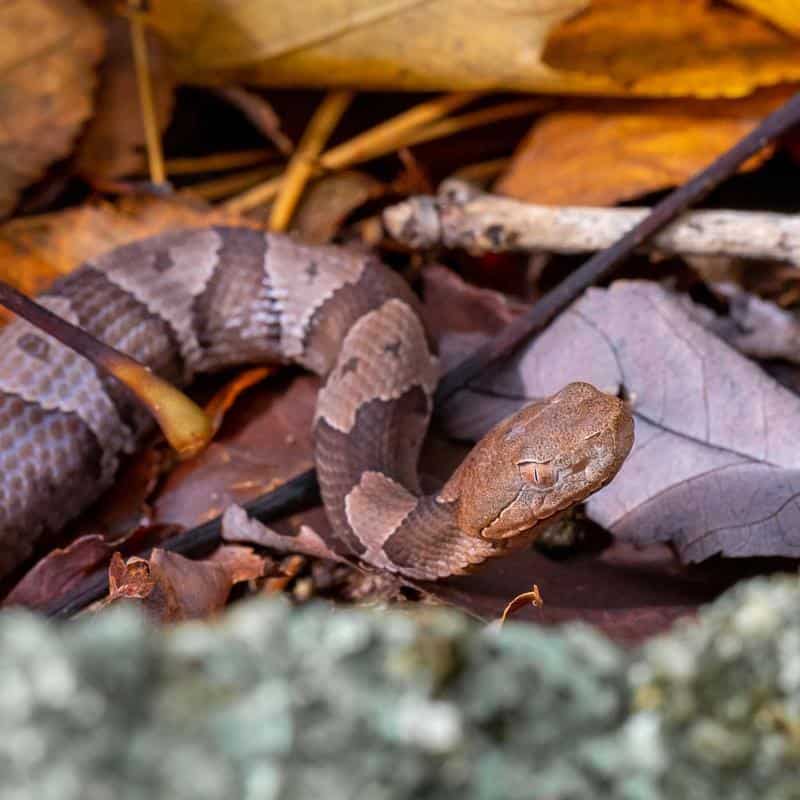
As the name suggests, the Northern Copperhead comes in copper, pink, and orange shades, with brown patches crossing the body. They grow up to 36 inches in length and have a copious body.
Generally, copperheads live on rocky, woody hillsides; they like to hide under leaf litter or large moist rocks in the Smoky Mountains. They feed on mice, small birds, snakes, frogs, and insects. The mating season is between spring and fall. Females give birth to litters averaging 1-10 young in late summer.
Copperheads are shy and tend to hide from open view. They are deadly snakes, so do not approach or attempt to kill if you see one. They strike to bite! But only when provoked. Although their bite is not lethal, it causes intense pain.
9. Timber Rattlesnakes
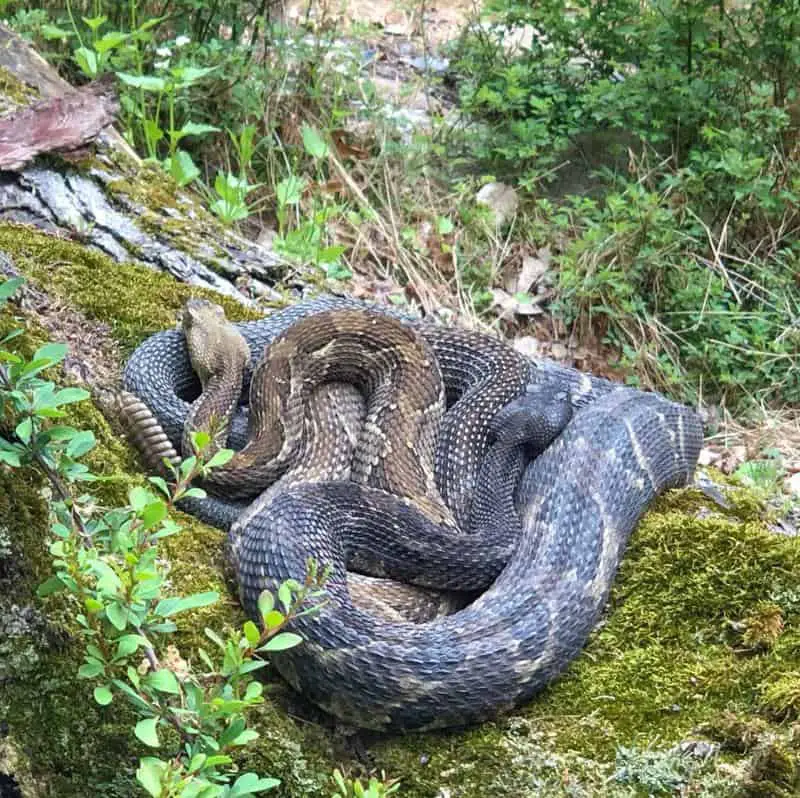
This is a medium to a large venomous snake that lives above 3,000 feet. It is relatively thick, with black or brown cross bands with chestnut, gray or yellow light backgrounds. Some Timber Rattlesnakes have a solid black hue and can grow up to 4.5 feet long.
The Timber Rattler is not known to be lethal. The Timber Rattler has the most toxic venom of the two species. Still, they will also give off warning signals before striking, that infamous loud rattle that lets you know you are too close.
Other Common animals in the Smoky Mountains
10. Salamanders
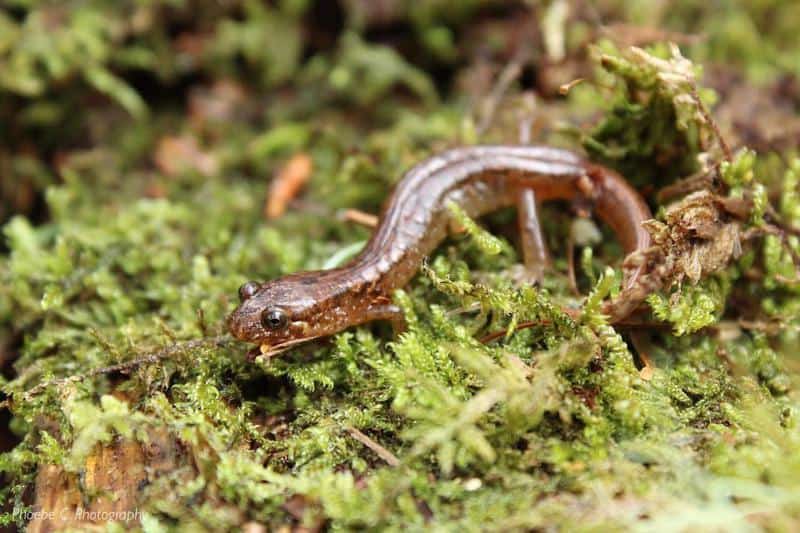
The Great Smokies are referred to as the “Salamander Capital” due to their abundance in the Southern Mountains. The red-cheeked salamander is lungless and “breathes” through their skins, and visitors are advised not to touch or try to pet one if they spot it.
The biggest salamander can grow to more than two feet long. Salamanders slither through wet areas, mostly hiding under logs and large stones near the Park’s creeks. Others wander in terrestrial environments, including eerie caves in the high mountain forest. They feed on moths, flies, spiders, beetles, and snails.
If you want to see Salamanders up close in the Smokies, visit the creek side hikes, or walk along damp forest tracks in the Park: use good binoculars to zoom in on these slippery creatures in perfect view. And remember. You can’t touch them since you would be interfering with the breathing system.
11. The North American River Otter
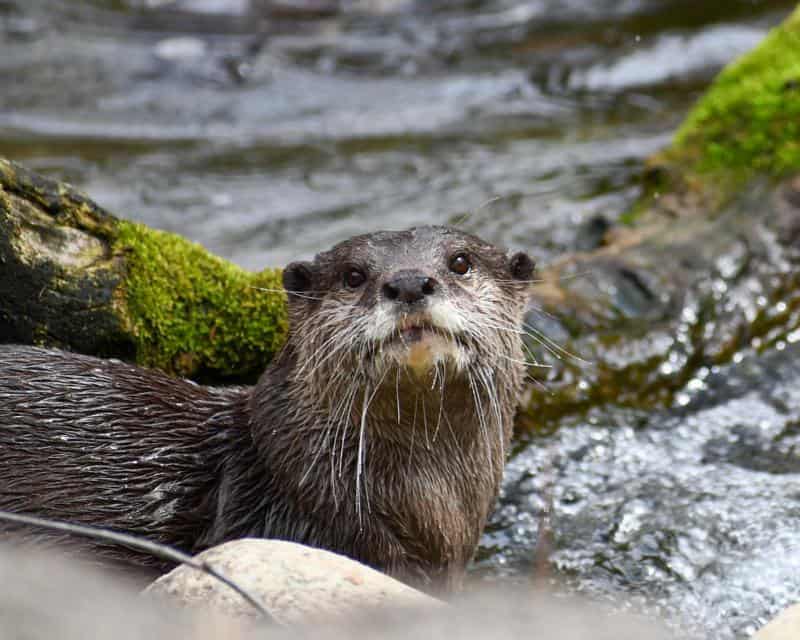
These creatures live around creeks and rivers in the Smoky Mountains Park. They live in social units – mostly a mother and her young ones until they mature. The adult male river otter also moves around in packs consisting of other males of up to 15 or more. These social groups make river otters playful.
River Otters are great swimmers, so you will often see them splashing and sliding in the wallows near the river banks – it’s the easiest way to find a group of otters.
River otters hunt the small amphibians’ that live in and along the rivers. They also eat lizards, crayfish and fish.
Otters skillfully wade through the water at great speed using their tail in search of prey. Once they spot a catch, they grab it and roll over on their backs to eat while still in the water.
If you are hiking through the mountains, it’s easy to see The North American River Otters having a good romp along the river banks.
Read More:
Tips for Watching Wildlife in the Great Smokies
The best season to visit the Great Smokies Park is in the spring and at the onset of summer. You’re likely to see countless species in your vicinity, whether driving along the forest or hiking in the mountains.
The best time to spot wildlife is at dawn when they come out of hiding to drink from the creeks or look for prey.
You can also find animals roaming in the Park around the Cades Cove at dusk – the best time to view wildlife in the Great Smoky Mountains.
Animals around the Cades Cove include black bears, deer, coyotes and many more.
The Oconaluftee Center and Cataloochee Valley is an ideal destination to see elks, specifically at dawn and at dusk.